
Catalog excerpts

It's good to know the facts passion vision innovation
Open the catalog to page 1
User's Guide to the key factors for selecting the right curing device Clinical relevance of light-curing systems Requirements of clinicians Compatibility with dental materials Light intensity Radiometry All about light probes Modern batteries last longer Ergonomics & design Quality vs. cost Checklist Bluephase® Style – The smallest LED for every use A quick guide to achieving optimum light-curing results Glossary of most commonly used terms in photopolymerization Literature
Open the catalog to page 3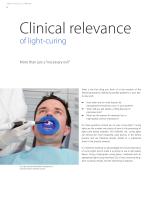
Clinical relevance of light-curing More than just a “necessary evil” What is the first thing you think of at the mention of the following questions relating to possible problems in your dayto-day work: ➡ ➡ ➡ How often and for what reasons do postoperative sensitivities occur in your patients? When did you last replace a filling because of premature loss? What are the reasons for retention loss in high-quality ceramic restorations? Do these questions remind you of your curing light? Curing lights are the number one source of error in the processing of light-cured dental materials...
Open the catalog to page 4
Questions from the (dental) practice As the proverb says, ‘The chain is only as strong as its weakest link’. Similarly, light-curing materials only perform as intended by their manufacturer if they receive the required amount of light energy and appropriate blue-violet wavelengths for polymerizing them [1]. There are a number of questions that clinicians should answer before they decide on a curing light, for instance: ➡ ➡ ➡ ➡ ➡ “What light intensity is required?” “What spectral emission range is required for the materials I use in my practice?” “What is the ideal light-curing technique?”...
Open the catalog to page 5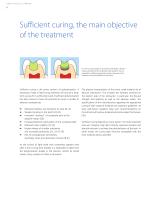
Sufficient curing, the main objective of the treatment Fig.: The top surface appears to be correctly cured (green) in both the entirely cured (left) and the insufficiently cured restoration. The risk presented by insufficient polymerization (grey) in deep areas of the restorations cannot be identified from the surface. Sufficient curing is the prime concern of polymerization. A restoration made of light-curing materials will only be a longterm success if it is sufficiently cured. Insufficient polymerization has been shown to have the potential to cause a number of adverse consequences: ➡ ➡ ➡ ➡...
Open the catalog to page 6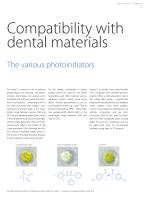
Compatibility with dental materials The various photoinitiators To convert a monomer into a polymer, photoinitiators are required. The photoinitiators decompose into radicals when irradiated with light and cause the monomers to polymerize. Camphorquinone is the most commonly used initiator. Camphorquinone absorbs light in the wavelength range between approx. 390 and 510 nm and displays a yellow colour, which is the complementary colour to blue light. Unfortunately, the yellow colour of champhorquinone affects the shade of the cured restoration [28]. Although the initiator almost completely...
Open the catalog to page 7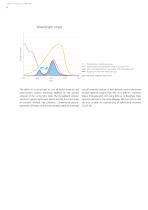
Wavelength range Photoinitiator: camphorquinone Photoinitiator: acyl phosphine oxide, e.g. Lucirin TPO LED curing light of the 2nd generation with monowave LED Bluephase® Style with Polywave® LED Source: R&D Ivoclar Vivadent AG, Schaan, 2014 The ability of a curing light to cure all dental materials and photoinitiator systems essentially depends on the spectral emission of the curing light. Given their broadband emission spectrum, halogen lights were able to activate the entire range of initiators without any problems. Conventional secondgeneration LED lights are not automatically suitable...
Open the catalog to page 8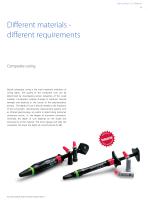
Different materials different requirements Composite curing Fig.: Tetric EvoCeram® Bulk Fill and Tetric EvoFlow® Bulk Fill Dental composite curing is the most important indication of curing lights. The quality of the composite cure can be determined by investigating certain properties of the cured material. Composites undergo changes in hardness, flexural strength and elasticity in the course of the polymerization process. The depth of cure is directly related to the irradiance of the curing light. Spectroscopic measurement systems such as infrared spectroscopy, are useful in determining...
Open the catalog to page 9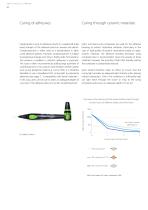
Curing through ceramic materials Inappropriate curing of adhesives results in a weakened shear bond strength of the adhesive bond on enamel and dentin. Camphorquinone is often used as a photoinitiator in lightcured adhesive systems. However, camphorquinone is subject to progressive changes over time in highly acidic formulations. This presents a problem in self-etch adhesives in particular. This issue is often circumvented by adding large quantities of camphorquinone or by using an acid-resistant initiator system such as acyl phosphine oxide (e.g. Lucirin TPO). It is therefore advisable to...
Open the catalog to page 10
Removal of excess material Curing of fissure sealants Until recently, processing adhesive luting composites was considered difficult because of the inconvenient removal of excess material. Modern luting composites (e.g. Variolink Esthetic) are designed for easy clean-up because they allow the excess material to be pre-cured to an ideal consistency with a short burst of light and then removed with a scaler. The fissure sealants available on the market are predominantly filled or unfilled one- or two-component systems. [73]. They are mostly based on methacrylate (e.g. Bis-GMA). A distinction...
Open the catalog to page 11
Wavelength range Conventional LED units of the 2nd generation Broadband LED units of the 3rd generation, e.g. Bluephase Style Relative intensity In order to safely use the dental materials in their practice, operators should be furnished with a “negative” list of all the incompatible materials by the manufacturers of conventional LED lights. However, such lists are often not to hand or they are incomplete. Using a curing device that emits light in a broadband spectrum is therefore the only way to ensure that a reliable cure is achieved. Relative intensity Relative intensity Acyl phosphine...
Open the catalog to page 12All Ivoclar Vivadent catalogs and technical brochures
-
PrograMill
9 Pages
-
Bluephase G2
6 Pages
-
Bluephase® Style
12 Pages
-
Fluor Protector S
8 Pages
-
Programat
18 Pages
-
3s PowerCure
12 Pages
-
FRC Postec Plus
8 Pages
-
IPS Empress®Direct
14 Pages
-
Prime
16 Pages
-
Astropol
2 Pages
-
Vivaglass
6 Pages
-
Total Etch
2 Pages
-
Telio System
8 Pages
-
Virtual
12 Pages
-
Zenotec select
8 Pages
-
Zenotec mini
6 Pages
-
Variolink Esthetic
10 Pages
-
Valiant Family
4 Pages
-
Tetric Evo-Family
20 Pages
-
Skyce
4 Pages
-
ProBase Hot & Cold
2 Pages
-
Plaque Test
2 Pages
-
Ortho Care
16 Pages
-
IPS Style
12 Pages
-
IPS Empress CAD - Dentist
8 Pages
-
Evetric
6 Pages
-
CAD-CAM Chairside - CEREC
24 Pages
-
Bluephase G2 and 20i
6 Pages
-
Brochure Service+
16 Pages
-
40 Years Programat
18 Pages
-
Cervitec Gel
2 Pages
-
Digital Denture
16 Pages
-
Heliosit
2 Pages
-
Ivostar - Gnathostar
2 Pages
-
IPS d.SIGN Opaquer F
2 Pages
-
IPS Ivocolor
10 Pages
-
IPS e.max Press Multi
12 Pages
-
IPS e.max CAD - Block Range
6 Pages
-
Implant Care
28 Pages
-
Centric Tray
2 Pages
-
bluephase 20i
4 Pages
-
bluephase
6 Pages
-
Programat® P710
10 Pages
-
PrograBase X10
2 Pages
-
10 years CaseBook
20 Pages
-
Helioseal®
6 Pages
-
OptraLine
10 Pages
-
OptraFine
2 Pages
-
Multilink Automix
8 Pages
-
Multilink Hybrid Abutment
4 Pages
-
Monobond Etch & Prime
4 Pages
-
Luting materials
12 Pages
-
Light-curing - special feature
32 Pages
-
IPS e.max Ceram
12 Pages
-
IPS Classic
2 Pages
-
i-Kids - Seal + Fill
4 Pages
-
CRT bacteria
6 Pages
-
Cervitec F
8 Pages
-
Bluephase Style Line
12 Pages
-
Direct Restoratives
6 Pages
-
Competence Implant Esthetics
12 Pages
-
CRT buffer
6 Pages
-
Bluephase Style Family
10 Pages
-
Adhese Universal
6 Pages
-
All-Ceramics chairside
2 Pages
-
Stratos 100 200 300
14 Pages
-
A ll-Ceramics Chairside
2 Pages
-
Programat CS3
8 Pages
-
Syntac
4 Pages
-
Scanners at a glance
4 Pages
-
Overview of Zenotec materials
22 Pages
-
Programat S1
8 Pages
-
Programat EP 5010
8 Pages
-
Programat P310
6 Pages
-
Programat P510
8 Pages
-
Programat P700-G2
10 Pages
-
SR Phonares II
8 Pages
-
Bluephase Meter
2 Pages
-
Bluephase Family
8 Pages
Archived catalogs
-
Helioseal
6 Pages
-
AdheSE
5 Pages
-
Programat EP 3010
6 Pages
-
Lumamat 100
4 Pages
-
Ivoclean
2 Pages
-
Heliosit Orthodontic
2 Pages
-
Heliomolar Family
6 Pages
-
Fluor Protector
8 Pages
-
ExciTE F - ExciTE F DSC
6 Pages
-
Competence in Implant Esthetics
12 Pages
-
Colado CC
4 Pages
-
Cervitec
2 Pages
-
Callisto CP+
4 Pages
-
BlueLine Plus
2 Pages
-
Astropol - Astrobrush
4 Pages
-
Apexit Plus - ApexCal
6 Pages
-
Alloy Catalog 2014
44 Pages
-
Accu-Dent System 1
4 Pages
-
UTS 3D
2 Pages
-
Ivomix
2 Pages
-
IvoBase System
6 Pages
-
Programat® CS2
6 Pages
-
Monobond Plus
4 Pages
-
Monobond Plus
2 Pages
-
IvoBase Injector
6 Pages
-
Programat CS
2 Pages
-
Prograbase 3
2 Pages
-
Silamat S6
56 Pages
-
Bluephase Style
8 Pages
-
Bluephase Family
8 Pages
-
Programat P500-G2
8 Pages
-
Programat EP3000-G2
10 Pages
-
bluephase C8
4 Pages




























































































































